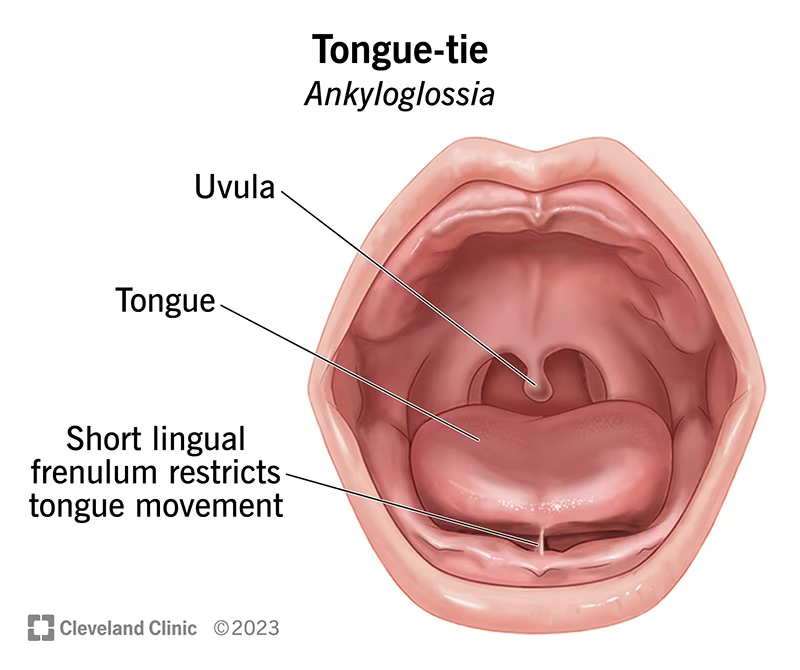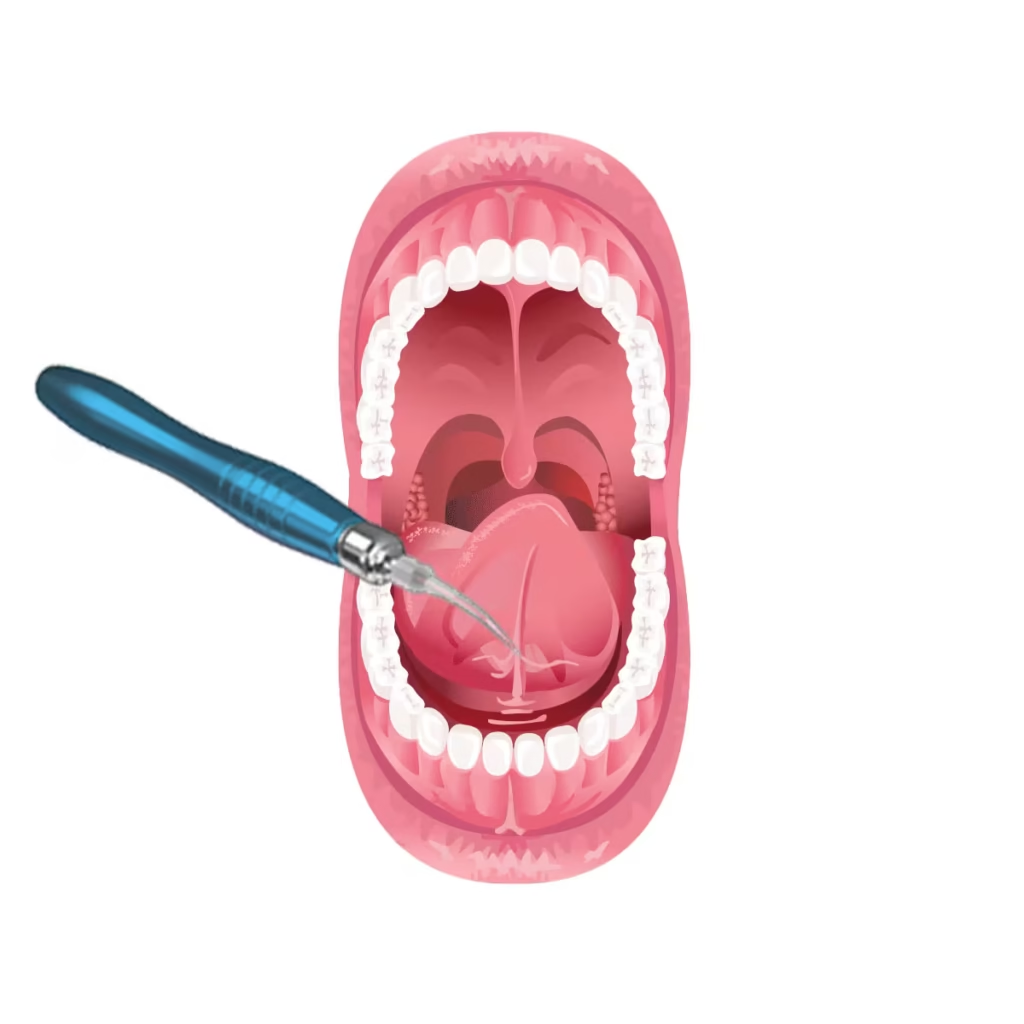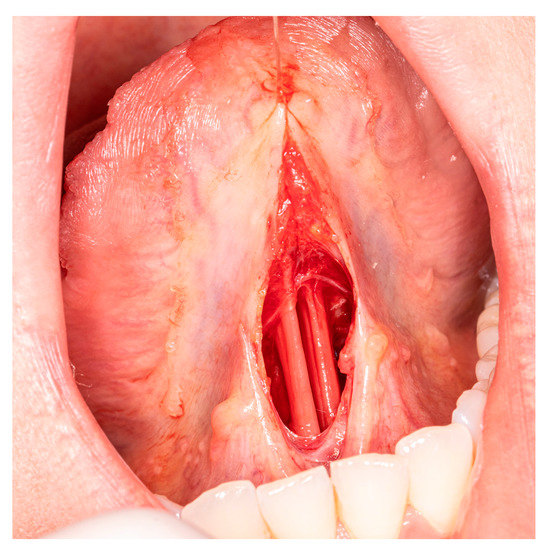What is a Tongue Tie?

A tongue tie, medically known as ankyloglossia, is a condition where the lingual frenum (the small piece of tissue connecting the underside of the tongue to the floor of the mouth) is unusually short, thick, or tight.
This restricts the tongue’s range of motion and can lead to various problems throughout life.
In individuals with tongue tie, this piece of skin is abnormally short and tight, limiting the tongue’s movement especially when extending outward.
This restriction can affect multiple aspects of daily life, as the tongue plays a crucial role in swallowing, eating, speaking, and other oral functions.
You might be interested: The Ultimate Guide To Seeing A Dentist In Singapore
What Causes a Tongue Tie?
Tongue tie is a congenital condition that a child is born with. It develops during fetal development when the lingual frenum does not separate properly as it typically would. The exact cause isn’t always clear, but genetic factors often play a role:
- It’s often part of a child’s genetic makeup
- It is not caused by anything parents did or didn’t do during pregnancy
- Tongue tie can run in families, so if a parent or close relative had it, a child may be more likely to have it too
How to Identify Tongue Tie
Signs in Babies
Tongue tie in infants can manifest through various feeding difficulties:
Signs of breastfeeding difficulties may include trouble latching, prolonged feeding sessions with short breaks between feeds, frequent frustration or fussiness during feeds, inadequate weight gain, clicking sounds while feeding, gagging or choking during feeds, milk leaking from the mouth during feeding, and maternal discomfort or pain during breastfeeding.
Read more: Pediatric Dentistry in Singapore: Complete Guide to Kids’ Dental Care
Signs in Toddlers and Children
As children grow, tongue tie symptoms may become more apparent in their speech and oral activities:
Signs of tongue-tie may include difficulty making certain speech sounds like “t,” “d,” “l,” and “r,” limited ability to stick out the tongue, a heart-shaped tip of the tongue when extended, trouble licking lips or eating certain foods like ice cream, speech delays or unclear speech, difficulty moving the tongue side to side, a gap between the lower front teeth, and problems with oral hygiene due to limited tongue movement.
This might help :Which Kids Dentist in Singapore Should You Consider? (Sort by Reviews)
Signs in Adults
In adults, untreated tongue tie can cause:
Consequences may include challenges in social and work environments that impact self-esteem, difficulty brushing away food debris and swallowing, poor dental health such as tooth decay and gingivitis, neck and shoulder tension, headaches, sleep problems such as snoring and sleep apnea, and difficulty with speech and articulation.
Read more: Which Dental Clinic in Singapore Should You Consider? (Sort by Reviews)
Why is Tongue Tie a Cause for Concern?
While some individuals with tongue tie experience minimal difficulties or adapt well to the condition, for others, it can present significant challenges across different stages of life:
In Infants
In infants, tongue-tie may lead to breastfeeding difficulties due to poor latch, maternal discomfort and complications like milk blebs and sores, feeding problems including reflux, gas and poor weight gain, milk leaking from the mouth during feeding, and poor nourishment with sleeping problems.
In Children
In children, it can result in restricted tongue movement affecting essential functions, difficulty with moving food and swallowing, impact on speech development and sound formation, and challenges with certain speech sounds.
In Adults
In adults, tongue-tie may cause social and professional limitations, reduced self-esteem, poor oral health and dental issues, and chronic discomfort including neck and shoulder tension with headaches.
Related article: Best Dental Clinic in JB for Singaporeans
Types of Tongue Tie Surgery
There are several approaches to treating tongue tie, with the most common surgical procedures being:
1. Frenotomy

This is a simple and quick procedure that can be done in a doctor’s office. The dental specialist or dentist will use a small, sterile tool (surgical blade, electric knife, or laser) to snip the lingual frenum, freeing the tongue.
For newborns, the procedure is carried out in a day surgery center where anesthesia may not be required for very young infants, breastfeeding can resume immediately post-surgery, and it is typically painless for young infants as there are few nerve endings in the frenulum.
2. Frenuloplasty

For older children, adults, or more complex cases where the lingual frenum is thick:
More extensive surgery may require stitches, uses surgical techniques to release the frenulum, is usually performed under local or general anesthesia, and may be necessary when the tongue tie is more severe.
You might like: Common Dental Problems in the Elderly: Symptoms, Prevention, and Treatment
The Tongue Tie Surgery Procedure
Consultation and Examination
Before any procedure, a thorough assessment is conducted:
- The dental specialist/dentist will take a detailed medical and dental history
- A consultation and examination will be performed
- Digital X-rays of the teeth may be taken for a thorough diagnosis
- The doctor will discuss and recommend the most appropriate solution
The Surgery
The correction of a tongue tie is a minor oral surgical procedure:
- Preparation: The area is numbed using local anesthesia (for older children and adults) or a topical anesthetic (for infants)
- Procedure: The dental specialist/dentist removes the lingual frenum with a surgical blade, electric knife, or laser
- Closure: The surgical site is closed with resorbable sutures and a pressure pack is applied
- Duration: The entire procedure takes about an hour to complete
Sedation Options
Depending on the patient’s age and comfort level:
- Local anesthesia: Used for most adults and older children
- Intravenous sedation: Available for those who are anxious about the procedure
- General anesthesia: Generally recommended for young children between ages 2-6 years
Related article: Choosing The Right Dental Surgeon in Singapore
Post-Surgery Care and Recovery
Immediate Care
For immediate care, under local anesthesia the operation site will be numb for 6-8 hours, so stick to soft foods and avoid hot foods or drinks during this time, cold soothing foods like ice cream are recommended, resume normal diet from the second day onwards, normal daily activities can be resumed almost immediately if the procedure was under local anesthesia, and if performed under intravenous sedation, rest is recommended on the day of the procedure.
Managing Discomfort
For managing discomfort, some facial swelling or pain may occur post-surgery, blood may ooze from the wound during the first few days, if bleeding occurs apply clean folded gauze to the wound and bite firmly for 5 minutes, if you taste blood swallow instead of spitting it out, and avoid rinsing or spitting during the first 24 hours to prevent disturbing the wound.
Ongoing Care
For ongoing care, one day after surgery rinse the mouth gently with an antiseptic mouthwash or warm salt water after meals and before bed, follow all instructions from your dental specialist to ensure proper healing, and attend follow-up appointments to monitor recovery.
Recovery Timeline
Recovery from tongue tie surgery is generally quick:
- Infants: Can usually resume feeding immediately after the procedure
- Children and adults: May experience some soreness for a few days
- Complete healing: Most patients heal completely within a few days to a week
- Benefits: Improvements in feeding, speech, or other functions are often noticeable quite soon after the procedure
Tongue Tie Surgery Fees in Singapore
| Service | Fee Range (SGD) |
|---|---|
| Consultation & Examination | $100 – 250 |
| Digital X-ray | $170 (OPG), $50 (PA) |
| Tongue Tie Surgery | $1,800 – 2,500 |
*All fees are subject to prevailing Singapore Goods and Services Tax. *All fees are subject to change without prior notice.
Additional Costs
For procedures requiring sedation or general anesthesia:
Sedation: Additional fee for an Anesthesiologist (approximately SGD$900 – SGD$1,000 per hour)
General anesthesia: Additional costs include Anesthesiologist fees, operating theatre costs, and hospital admission costs
MediSave Coverage for Tongue Tie Surgery
If you are a Singaporean or a permanent resident of Singapore, MediSave may be utilized to partially cover the applicable fees for tongue tie surgery. The amount covered depends on:
- The complexity of the surgery
- Final approval by the CPF Board
Is Tongue Tie Surgery Safe?
Tongue tie surgery is generally considered a low-risk procedure. Complications are rare, but as with any surgical procedure, there are some potential risks:
- Bleeding (typically minimal, especially with laser procedures)
- Infection (rare, but antibiotics can be prescribed if needed)
- Scarring
- Pain and swelling (usually manageable with pain relievers)
- Damage to the tongue or salivary glands (very rare)
- Reattachment of the frenulum (can occur if post-operative care instructions aren’t followed)
Benefits of Tongue Tie Surgery
Releasing the tongue from its restriction through surgery can provide numerous benefits:
- Improved oral function: Enhanced ability to move the tongue properly
- Better feeding: For infants, improved latch and feeding efficiency
- Enhanced speech: Better articulation and communication
- Better oral hygiene: Easier to clean teeth and maintain dental health
- Aesthetic improvement: More natural tongue movement and potential closure of gaps between teeth
- Overall quality of life: Reduced discomfort and increased confidence
Long-term Effects if Tongue Tie is Left Untreated
If tongue tie is not addressed, several outcomes are possible:
In some individuals, the condition may resolve naturally as the mouth develops, while others may experience persistent difficulties with eating and speech, speech therapy may be needed to help improve speech sounds, and various challenges may persist into adulthood affecting quality of life.
Controversy in Tongue Tie Treatment
It’s worth noting that there has been some controversy regarding the diagnosis and treatment of tongue tie:
There has been a significant increase in diagnoses and procedures in recent years, some medical professionals have raised concerns about potential overdiagnosis, the procedure has been described by some as a “quick fix” that may not always be necessary, and it’s important to get a thorough evaluation from qualified medical professionals.
When to See a Specialist
Consider consulting a specialist if:
Consider seeking evaluation if your infant has persistent difficulties with breastfeeding, you notice speech delays or unclear speech in your child, your child struggles with basic tongue movements, there are feeding difficulties including gagging or choking, or your dentist raises concerns about the impact of tongue tie on dental development.
FAQs About Tongue Tie Surgery
What exactly happens during a frenotomy procedure?
During a frenotomy, the dental specialist uses sterile scissors, a surgical blade, electric knife, or laser to cut the lingual frenum (the tissue connecting the underside of the tongue to the floor of the mouth).
This releases the tongue’s restriction, allowing for improved movement. The procedure is quick, typically taking less than 15 minutes, and for infants, it often requires minimal or no anesthesia.
At what age should tongue tie be corrected?
There is no specific age requirement for tongue tie correction. The decision depends on symptoms and the impact on quality of life.
For infants with feeding difficulties, early intervention (within the first few weeks or months) can be beneficial. For older children with speech issues, correction can be done when problems become apparent.
Adults can also undergo the procedure if they experience limitations or discomfort.
How do I know if my baby’s tongue tie needs correction?
Consider tongue tie correction if your baby shows signs such as difficulty latching during breastfeeding, prolonged feeding sessions, clicking sounds while feeding, inadequate weight gain, or if the mother experiences significant pain during breastfeeding.
A healthcare professional specializing in infant oral health can provide an assessment to determine if intervention is necessary.
Does tongue tie surgery hurt?
Pain experience varies by age. Infants feel minimal pain during the procedure as there are few nerve endings in the frenulum.
Older children and adults who receive local anesthesia may experience some discomfort after the anesthesia wears off, but this is typically manageable with over-the-counter pain relievers. Recovery discomfort is usually mild and short-lived.
Will my child need speech therapy after tongue tie surgery?
Not all children will need speech therapy after tongue tie release. However, if a child has already developed compensatory speech patterns due to limited tongue movement, speech therapy may be beneficial to help them learn proper articulation.
The need for therapy depends on the child’s age, the severity of speech issues before surgery, and how they adapt to their new tongue mobility.
How soon can a baby breastfeed after tongue tie surgery?
Babies can typically resume breastfeeding immediately after the procedure. In fact, nursing right after the procedure is often encouraged as it can provide comfort to the baby and help establish proper latching with the newly released tongue.
Some improvement in feeding may be noticed immediately, while full adaptation to the new tongue mobility may take a few days.
Are there any non-surgical options for treating tongue tie?
In mild cases, non-surgical approaches such as tongue exercises or speech therapy may help manage the symptoms of tongue tie.
However, these alternatives don’t address the physical restriction itself. For significant limitations in tongue movement that affect feeding or speech, surgical correction remains the most effective treatment option.
Can a tongue tie grow back after surgery?
In some cases, the frenulum can partially reattach during healing, especially if post-operative care instructions aren’t followed. This is more common in procedures that don’t include stitches.
To prevent reattachment, doctors may recommend gentle stretching exercises for the tongue during the healing period. If reattachment occurs, a second procedure may be necessary.
Is general anesthesia necessary for tongue tie surgery?
General anesthesia is typically not necessary for tongue tie surgery in most patients. Local anesthesia is usually sufficient for adolescents and adults, while infants may require minimal or no anesthesia.
However, general anesthesia may be recommended for young children (typically ages 2-6) who might have difficulty remaining still during the procedure or who experience high anxiety.
How will I know if the tongue tie surgery was successful?
Success is measured by improvement in the symptoms that prompted the surgery. For infants, this might include better latch during feeding, reduced maternal pain during breastfeeding, shorter feeding times, or improved weight gain.
For older children and adults, improvements in speech clarity, tongue mobility, and comfort eating certain foods indicate success. Full benefits may take some time to become apparent as the patient adapts to the increased tongue mobility.

